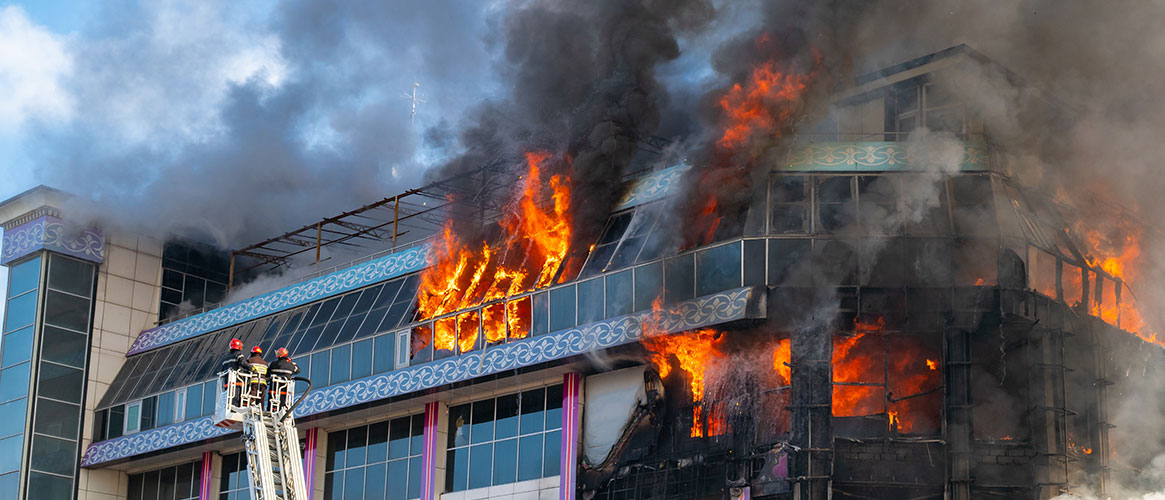No matter the size or type of your business, the potential for workplace fires is present. The risk is likely higher in more industrial operations such as welding, but a small paper fire or electrical short can also ignite a devastating fire inside an office building. The best way to avoid damage and injuries from workplace fires is to prevent them from happening in the first place. In fact, Cal/OSHA requires all businesses to have a Fire Prevention Plan. If you have more than 10 employees, this plan must be in writing. If you have 10 or fewer employees, you may communicate it orally.
Your Fire Prevention Plan identifies the risks at your workplace and your control measures. It also covers maintenance of fire extinguishers and other suppression equipment and the collection and disposal of flammable/combustible materials.
Below, you’ll find five steps that can help you with your plan, protect your business, and protect your employees.
Good housekeeping
Make a point to regularly check for fire hazards:
- Inspect cords for breaks, frays, and ensure they’re plugged firmly into the outlets.
- Don’t overload power strips, surge protectors, or “daisy chain” these items together.
- Avoid storing materials in front of emergency exits or fire extinguishers.
- Keep paper products, aerosols, chemicals, and other flammable materials away from heat sources.
- Keep appliances clean and free of spilled fats, sugar, sauces, etc.
- Turn off tools or appliances if they produce a burning smell, smoke, sparks, or flickering lights.
Fire extinguishers
All businesses must have fire extinguishers and they must be the right type of extinguisher for your workplace:
- Class A fires include wood, paper, and textiles.
- Class B fires include flammable liquids.
- Class C fires include electrical equipment.
- Class D fires include metal powders and shavings.
- Class K fire extinguishers are required for commercial and restaurant kitchens.
Your employees need to be trained to use fire extinguishers properly. During an emergency it’s easy to forget important steps such as pulling the pin before squeezing the handle.
Use our safety meeting topic on the P.A.S.S. method to train your employees on how to use a fire extinguisher.
If a fire extinguisher is empty, doesn’t extinguish the blaze, or your employees have any doubts about fighting the fire, evacuate the workplace immediately in accordance with your emergency action plan.
Fire detection systems
A smoke alarm, heat detector, and/or flame detector provides an instant alert when fire or smoke is present. Your employees can react quickly when they hear the sound whether they need to use a fire extinguisher or exit the workplace. In accordance with Cal/OSHA regulations, regularly test and maintain your fire detection systems. You also need to make sure these devices are protected from corrosion or other potential damage and provide enough warning time for employees to evacuate the workplace.
In addition to your alarm systems, remind your employees that if they smell something burning, see smoke, or flames to speak up right away.
Hazardous chemical storage
Many workplaces have hazardous chemicals present. These could be as simple as cleaning solutions you store at the office or large containers of hazardous materials stored in warehouses or transported on trucks or ships. In all cases, they pose a risk for potential workplace fires. When storing chemicals, make sure to keep incompatible groups apart. Check the safety data sheets and the hazard labels for further information.
For more information and to train your employees, see our safety meeting topic on chemical storage.
Don’t let oil or solvent soaked rags accumulate around the work area. Dispose of these rags—and other solvent waste—in fire-resistant, covered containers until removed from your workplace.
Emergency planning, evacuation
All employers must have an emergency action plan (EAP) and communicate it to employees. This document covers a number of potential emergencies, including fire, and spells out the responsibilities each employee has when the plan has to be activated. Our Emergency Preparedness & Response Training Video takes you through the steps of developing your own EAP checklist, which helps you ensure that everyone at your workplace is prepared in case of emergency.
Part of the EAP includes procedures on how to evacuate. Getting your employees out of the workplace safely is your top priority. Practice this plan throughout the year to help ensure an orderly exit in case of fire or other emergency.
Remember, no matter the size or type of business, the risk of workplace fires is present. Having a plan and training your employees how to react quickly will help protect your workplace and reduce the risk of injuries and fatalities should a fire break out.
